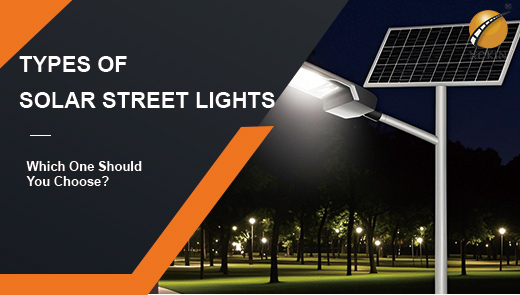The Ultimate Guide to Selecting Poles for Your LED Solar Street Lights
Understanding LED Pole Lights
The importance of solar street lights in modern infrastructure
In today's era of pursuing sustainable development, solar street lights have become an important part of modern infrastructure by virtue of their significant energy-saving features and environmental advantages. Solar street lights utilize solar energy to convert into electricity, reducing the dependence on traditional electricity and greatly reducing energy consumption and carbon emissions.
At the same time, solar street lights play a key role in enhancing the safety and security of outdoor areas. At night, sufficient and stable lighting enables pedestrians and vehicles to clearly identify road conditions, greatly reducing the likelihood of accidents.
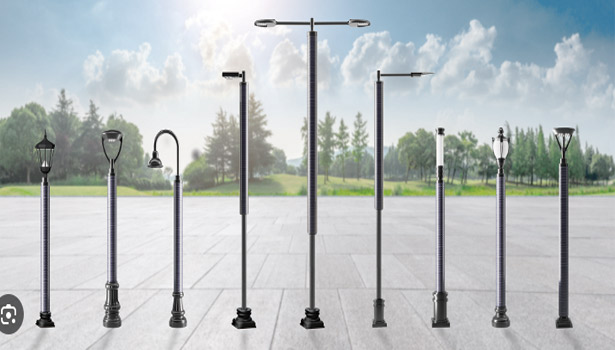
The key role of light poles in the function and appearance of solar street lights
As the support structure of solar street light, the pole carries important parts such as lamps, solar panels, etc., and plays a fundamental role in supporting the normal operation of street light. The right height and strength of the pole can ensure that the lamps and lanterns are in the best position to realize good lighting range and effect, so that the light evenly covers the area that needs to be illuminated.
In terms of appearance, the design of the pole and the choice of material will have a direct impact on the overall visual effect. A beautiful and coordinated light pole with the surrounding environment can enhance the overall aesthetics of streets, neighborhoods and other areas, adding charm to public and private spaces.
Why Choosing the Right Street Light Pole Matters
Safety and accident prevention
Proper selection of light poles is the basis for ensuring the best lighting effect on roads. Light poles of sufficient height and reasonable spacing allow streetlights to illuminate every corner of the road, eliminating dark dead zones. Vehicle drivers and pedestrians can clearly see the road conditions, obstacles and traffic signs in front of them, so as to react in time and effectively reduce the probability of traffic accidents.
According to relevant statistics, in some poor lighting conditions on the road, the rate of traffic accidents than well-lighted roads 30% - 50% higher. Among them, the accidents caused by improper height of light poles and insufficient lighting range leading to obstructed vision account for a large proportion.
Multi-functionality of street lights
Solar street lights have a wide range of lighting applications, not only for lighting roads, but also for parking lots, sidewalks and other areas. In parking lots, uniform lighting helps drivers to park and reverse safely; lighting on sidewalks ensures the safety of pedestrians traveling at night.

Meanwhile, streetlights are also instrumental in beautifying public and private areas. Unique design, excellent materials, light poles and lamps and lanterns with, can become part of the city landscape. In some high-grade residential areas, the elegant shape of the solar street light poles to enhance the overall grade of the district and the quality of the living environment.
Factors to be considered when choosing a new light pole
Light pole height
The importance of conducting height research
Determining the appropriate height of the light pole requires professional research. Through site visits, analysis of the surrounding environment and lighting needs and other factors, can develop an efficient street lighting plan. During the research process, it is necessary to understand the number of lamps and lanterns required for each pole, the model of lamps and lanterns, and the number of poles and other information.
Commonly used research tools include professional lighting measurement instruments, which can accurately measure the light intensity requirements of different areas; at the same time, with the help of geographic information system (GIS) technology, you can intuitively analyze the regional topography and the impact of surrounding buildings on lighting.
Height requirements for different application scenarios
- Residential trails and gardens: In general, residential gardens, trails or driveway lighting pole height of 3 to 7 feet (about 0.9 to 2.1 m) is more appropriate. This height will project light down the path or garden and provide adequate illumination without creating excessive glare that would interfere with residents' daily lives.
- Street Lighting and Parking Lots: In areas where safety and visibility are critical, such as streets and parking lots, pole heights typically range from 12 to 30 feet (approximately 3.7 to 9.1 meters). The exact height is determined by the spacing of the poles, the lighting technology used, and the width of the area to be illuminated. For example, on a wide, two-way, four-lane street, a pole height of about 20 feet might be selected to ensure that the entire roadway is evenly illuminated, with poles spaced about 30 meters apart.
- Commercial Outdoor Areas: Commercial spaces such as outdoor rest areas, sidewalks, or entrances generally have light pole heights of 10 to 20 feet (approximately 3 to 6 meters). This height meets the need for adequate lighting and creates a pleasant atmosphere to attract customers. For example, in the outdoor plaza of a shopping center, a 15-foot pole with warm-toned fixtures creates a comfortable shopping environment.
- Security Lighting: In areas where security is the primary purpose of lighting, pole heights can vary greatly depending on specific needs. In order to achieve wide-angle lighting, covering a large area, the pole may be as high as 20 to 30 feet (about 6 to 9 meters). For example, in some factory perimeter fencing area, in order to monitor and security without dead angle, the use of 25-foot high poles, with high brightness, large angle light fixtures.
- Sports and recreational venues: sports venues or large recreational areas with special lighting needs, light poles are usually very high, generally in the 40 to 100 feet (about 12 to 30 meters) or even higher. This height ensures that large areas are adequately illuminated while minimizing shadows and glare and not interfering with the athlete's game or the spectator's viewing experience. For example, a standard soccer field may be illuminated with a pole height of 60 feet or more and equipped with professional sports lighting fixtures.
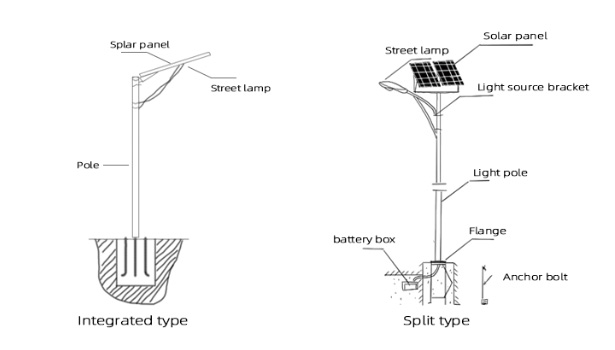
Installation Types
Different installation types
- Direct installation: directly fix the lamps on the pole, the installation is relatively simple and direct, suitable for some of the lamps installation angle requirements are not high, and the weight of the lamps and lanterns is light. For example, in some neighborhood internal road lighting, if the use of small, simple solar lamps and lanterns, you can use direct installation.
- Slide-in installation: the lamps are installed on the light pole through a specific slide-in structure, which is relatively easy to install and dismantle, and facilitates the maintenance and replacement of the lamps at a later stage. This type of installation is often used in some need to regularly replace lamps or adjust the location of the lamps, such as commercial pedestrian street lights, may be adjusted according to the needs of different seasons or activities of the lamps.
- Adjustable installation: this installation allows the lamps to adjust the angle within a certain range, according to the actual lighting needs to flexibly change the direction of light projection. For example, in some complex terrain or special lighting needs of the region, such as parks, curved trails, adjustable installation of the lamps can better illuminate the road direction.
- Universal installation: strong versatility, able to adapt to a variety of different types of lamps and lanterns, the application of a wide range of scenes. In some temporary lighting projects or places with high compatibility requirements for lamps and lanterns, universal installation can provide a convenient solution.
Select the appropriate installation type according to the use of the scene
When choosing the installation type, you need to fully consider the characteristics of the use of the scene. For example, in the parking lot, due to the vehicle parking position and direction is more regular, the angle of the lamps and lanterns to adjust the demand is relatively small, slide into the installation or direct installation may be more appropriate, not only to facilitate the installation and can meet the lighting needs; and in the park and other landscaping areas, in order to better illuminate the landscape of the different positions and paths, the adjustable mounting type is more advantageous.
Wind speed
The necessity of consulting wind speed data with local authorities
Solar street lights are usually installed outdoors and will face various natural weather conditions, among which the impact of wind speed on the light poles should not be ignored. The wind speed varies greatly in different areas. Consulting the local meteorological department or relevant management department for accurate wind speed data is an important prerequisite to ensure the safe and stable operation of the street light.
The impact of wind speed on the size and installation of light poles
Higher wind speed requires stronger wind resistance of the pole. According to the wind speed data, engineers need to choose the right size and strength of the light pole. Generally speaking, the higher the wind speed, the diameter and wall thickness of the pole need to be increased accordingly to improve the stability of the pole. In terms of installation, stronger foundations and mounting methods are also required. For example, in coastal areas, due to the frequent influence of the sea breeze, wind speed is higher, the light pole may need to use a thicker tube diameter, and the foundation should be deeper into the ground deeper position, and the use of high-strength ground bolts for fixing.
Examples of high wind speed light pole designs
Some light poles specially designed for high wind speed areas use a special tapered design, which can effectively reduce wind resistance and enhance the stability of the pole in strong winds. At the same time, in the choice of materials, the use of high-strength steel, and the surface of the light pole for special treatment, to improve its resistance to wind erosion.
Environmental factors
The impact of different environments on the durability of light poles
In coastal areas, street light poles face severe tests. Salt in seawater adheres to the surface of light poles with air flow, which is very easy to trigger corrosion of light poles. According to research, in coastal areas, without special protective treatment of metal light poles, its corrosion rate is 3 to 5 times faster than inland areas.
In some areas of serious industrial pollution, acidic gases and particles in the air will also cause corrosion and erosion of the lamp post, affecting the service life of the lamp post.
Protective Measures
In order to cope with the coastal and other harsh environments, the use of high-quality light pole materials is the first choice. For example, the use of stainless steel or special alloy treatment of steel, these materials itself has good corrosion resistance.
In addition, applying a special anti-corrosion coating to the surface of the pole is a common means of protection. The coating can form a layer of protective film to prevent salt, acidic substances and other direct contact with the lamp post metal. Common anti-corrosion coatings include hot-dip galvanizing coatings, epoxy zinc-rich coatings, etc. These coatings can significantly improve the corrosion resistance of light poles and extend their service life.
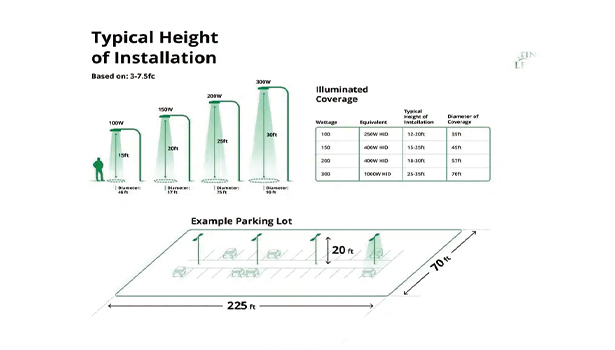
What is the size of the solar street light pole?
Height considerations
Height differences based on application scenarios
- Residential applications: In residential areas, the height of solar street light poles used for garden paths and patio lighting is usually 3 to 8 feet (about 0.9 to 2.4 meters). This height range can provide warm, comfortable lighting for residential environments without too much interference with residents' privacy. For example, a 5-foot pole with soft solar fixtures in an average single-family home's yard can illuminate yard paths while creating a serene atmosphere.
- Commercial applications: Solar street light poles for commercial use require higher heights. In street lighting, parking lots and other scenarios, the height of the pole is generally 10 to 30 feet (about 3 to 9 meters). For some special large sites, such as highway lighting or lighting around large stadiums, the pole height may exceed 30 feet. For example, in the parking lot of a large commercial complex, the pole height may be set at 15 feet in order to ensure uniform illumination throughout the parking lot and to distribute the pole spacing appropriately to achieve the best lighting effect.
Impact of Height on Lighting Coverage and Energy Efficiency
Pole height is directly related to lighting coverage. Higher poles allow light to reach farther and wider areas. For example, a 20-foot pole may increase the radius of coverage by 5 to 10 meters compared to a 10-foot pole. The right pole height also improves energy efficiency. If the pole is too low, more lamps may be needed to achieve the same lighting effect, thus increasing energy consumption; while too high a pole may result in too much light dispersion, poor lighting effect, and also waste of energy. Therefore, choosing the right height of the pole is crucial to achieving energy efficient lighting.
Diameter Consideration
Diameter range for different application scenarios
- Residential and light commercial applications: In residential and some light commercial locations, such as sidewalk lighting in front of small stores, the pole diameter is usually 2 to 6 inches (about 5 to 15 cm). This range of diameters allows for the support of small fixtures and solar panels while maintaining pole stability. For example, a 4-inch diameter pole with a minimalist solar fixture on a neighborhood shopping street is both aesthetically pleasing and practical.
- Heavy commercial and industrial applications: For large commercial centers, factories and other heavy commercial and industrial sites, the light poles need to withstand more weight, including large lamps, multiple solar panels, and the possible impact of bad weather. As a result, the diameter of the poles in these locations increases significantly, sometimes to 8 inches (about 20 cm) or more. For example, in a large logistics park, in order to support the high brightness of the lighting fixtures and a large area of solar panels, the pole diameter of 8 inches to ensure that the pole in a variety of conditions can be stable operation.
Relationship between Diameter, Height and Carrying Capacity
The diameter and height of the pole are closely related to the carrying capacity. Generally speaking, the higher the height, the greater the need to withstand the wind and other external forces, and therefore require a thicker diameter to provide sufficient support strength. At the same time, the pole needs to carry the weight of the lamps, solar panels, batteries and other components, the diameter of the pole can be increased to improve the carrying capacity, to ensure the safety and stability of the entire street light system. For example, a 15-foot high light pole, if you want to carry heavy high-power lamps and large solar panels, its diameter may need to choose 6 inches or so, to meet the load requirements.
The effect of diameter on the overall stability of the pole
The appropriate diameter of the pole is one of the key factors to ensure the overall stability. Thinner light poles are prone to swaying or even tipping when exposed to external forces such as strong winds, while thicker poles provide greater wind resistance and stability. In some areas that often suffer from windy weather, choosing a larger diameter pole is an important measure to ensure the normal operation of street lights. For example, in grassland areas with strong winds, the diameter of the solar street light poles installed will usually be larger than in ordinary areas to withstand strong winds.
Other related factors
The impact of material selection on the size requirements of the light pole
Different light pole materials have different physical properties, which will affect the size requirements of the pole. For example, aluminum light pole is relatively light, in the same bearing capacity requirements, its diameter may be slightly thinner than the steel light pole. While the concrete light pole although high strength, but the weight of the large, in the design of the size of the foundation needs to be fully considered when the bearing capacity, its size may be relatively large.
Adjustable height or angle and other design features on the size of the lamp post
With adjustable height or angle design of the light pole, the structure will be more complex, may need to add some adjusting devices and strengthen the structure, which will have a certain impact on the size of the light pole. For example, height-adjustable light poles may require an internal lifting mechanism, which requires the pole to have a certain amount of internal space, which may result in an increase in pole diameter.
Foundation and Installation Requirements Based on Pole Size and Local Ground Conditions
The size of the pole and local ground conditions determine the foundation and installation requirements. Smaller sized light poles can have relatively simple foundations, such as in residential areas with good soil conditions, where a small concrete foundation may be sufficient. Larger commercial or industrial light poles, on the other hand, require stronger, deeper underground foundations due to their greater height and weight. In some areas with poor geological conditions, such as soft ground, special treatment of the foundation, such as the use of pile foundations, is also required to ensure the stability of the light poles.
Integration of solar panels, batteries and lighting fixtures and their impact on the size of the light pole
The size of the pole with integrated solar panels, batteries and lighting fixtures needs to take into account the volume and weight of these components. Larger sized solar panels and batteries require more mounting space, which may result in an increase in the diameter or length of the light pole. For example, for some solar streetlights with high-capacity batteries and large-area solar panels, the pole may be designed to be thicker and taller to accommodate and support these components.
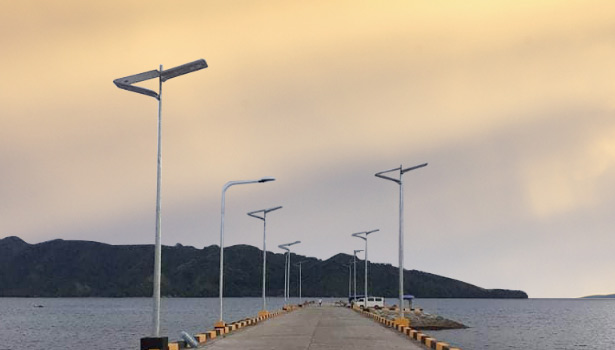
What are the Types of Materials for Light Poles?
Wood street light poles
- Cost advantage: The biggest advantage of wood as a light pole material is its lower cost. Compared with other materials, the cost of obtaining and processing wood is relatively easy to control. For some small projects with limited budgets or cost-sensitive application scenarios, wood light poles may be an economical choice.
- Disadvantages in appearance, weight and installation complexity: Timber light poles are relatively common in appearance, lacking a sense of modernity and fashion, making it difficult to blend in with some high-end architectural or landscape environments. And wood is heavier, in the transportation and installation process requires more manpower and equipment investment, increasing the complexity and cost of installation.
- Susceptible to decay, cracking, warping and pests: Wood is easily affected by natural environmental factors. In a humid environment, wood is prone to decay, reducing its structural strength; changes in temperature and humidity may also lead to wood cracking and warping, affecting the stability and appearance of the light pole. In addition, wood is susceptible to insect attack, further shortening its service life.
- Examples of applicable scenarios: In some rural areas or small private gardens where natural style is pursued, timber light poles may be chosen. For example, in a country resort, the use of preservative-treated wood light poles with rustic lamps creates an atmosphere that harmonizes with the surrounding natural environment.
Fiberglass street light poles
- Diversity of shapes and colors: Fiberglass is highly malleable and can be molded into a variety of unique shapes and colors. This allows fiberglass light poles to be customized according to different design needs and environmental styles to meet individual aesthetic requirements. Whether it is a modern minimalist style or vintage European style landscape project, you can find the right fiberglass light pole design.
- Light weight and waterproof: Fiberglass material is relatively light, easy to transport and install, which can reduce the labor and material costs in the construction process. At the same time, it has better waterproof performance, and can maintain better performance in wet environment, reducing the risk of damage caused by moisture erosion.
- Compared with other materials in terms of strength and durability: However, fiberglass light poles are not as strong and durable as some metal materials. When subjected to large external forces or in the course of long-term use, problems such as wear and deformation may occur. Its service life is relatively short and may require more frequent replacement and maintenance.
- Cost Comparison: The cost of fiberglass light poles is usually higher than that of timber light poles, and may also be slightly higher compared with some ordinary steel light poles. This is mainly due to the characteristics of the material itself and the complexity of the processing technology.
Aluminum street light poles
Light weight and anti-rust properties
The biggest highlight of aluminum is its light weight and excellent anti-rust properties. Compared with steel, the density of aluminum is smaller, which makes aluminum light poles in the handling and installation process is more convenient, greatly reducing the input cost of manpower and equipment. In coastal environments with high humidity and high salt content, ordinary steel poles are very prone to rust and corrosion, while aluminum poles, with their natural rust resistance, can maintain good appearance and structural integrity for a long time, which greatly reduces the frequency of maintenance and replacement.
Advantages of hollow structure for internal wiring
Aluminum light poles mostly use hollow structure, this design provides great convenience for internal wiring. Compared with the external wiring, the internal wiring not only makes the appearance of the pole more neat and beautiful, but also effectively protects the wires from the erosion of the external environment, such as ultraviolet irradiation, rain wash and physical collision, thus extending the service life of the wires and reducing the risk of line failure.
Various appearance treatment options
Aluminum light poles can be enhanced through a variety of surface treatment processes to improve its appearance and corrosion resistance. Anodic oxidation treatment can form a hard and dense oxide film on the aluminum surface, which not only enhances the wear resistance of the pole, but also provides a variety of colors to choose from, such as silver, black, gold, etc., which can be matched according to different environments and design styles. In addition, the powder coating process can make the surface of the light pole get richer color and texture, further meet the diversified aesthetic needs.
Stability consideration and cost comparison in wind environment
However, the stability of aluminum light poles in the face of strong wind environment is relatively weak. Due to the low density of the material, the mass of aluminum light poles of the same size is smaller than that of steel light poles, which is easier to produce shaking under the action of strong winds. Therefore, the use of aluminum poles in windy areas often requires a more stable design of the foundation or additional wind protection measures. In terms of cost, aluminum poles are usually more expensive than steel poles, mainly due to the raw material cost of aluminum and the complexity of the processing. However, considering its advantages in rust prevention and maintenance, aluminum poles are still cost-effective for projects with high demands on appearance and harsh environments.
Steel street light poles
Popularity as the most common choice for outdoor light poles
Steel is undoubtedly the most widely used material for outdoor light poles. It occupies a dominant position in all kinds of lighting projects, from the main road of the busy city to the quiet countryside paths, everywhere you can see the figure of steel light poles. This wide range of applications stems from its many excellent characteristics, making it the material of choice for most lighting projects.
Strength, robustness and economic feasibility
Steel is extremely strong and sturdy and can withstand great external forces such as strong winds, heavy rain and accidental collisions. In the face of adverse weather conditions, steel light poles can remain stable, not easy to deformation or fracture, for the normal operation of the street light system provides a reliable guarantee. At the same time, the production process of steel is mature, and the supply of raw materials is sufficient, which makes the steel light poles have a significant advantage in terms of cost. Compared with some other high-performance materials, steel poles can provide reliable quality at a more reasonable price to meet the economic needs of large-scale lighting projects.
Ability to withstand severe weather and strong winds
Steel light poles show excellent resistance to extreme weather conditions such as hurricanes and blizzards. Its high-strength characteristics enable it to withstand strong winds and snow pressure, to ensure that the street lights continue to illuminate, to provide security for people's travel safety. For example, in some coastal areas often hit by typhoons, steel light poles after special wind design and reinforcement treatment, can stand in the gale, maintain road lighting, to avoid traffic chaos and safety hazards caused by lighting interruption.
Risk of Rust and Importance of Coating Maintenance
Despite its many advantages, steel's greatest weakness is its susceptibility to rust. In a humid environment, the iron elements on the surface of steel will react with oxygen and moisture in the air and gradually form rust, which not only affects the appearance of the pole, but also weakens its structural strength. To combat this problem, it is vital to protect steel light poles with coatings. Common coating methods include hot-dip galvanizing and spray painting. Hot-dip galvanizing can form a thick layer of zinc on the surface of steel, effectively isolating it from oxygen and moisture and preventing it from rusting; spray painting can provide a variety of color options while providing some protection. However, the need for regular inspection and maintenance of the coating, timely repair of damaged parts to ensure the protective effect of the coating, to extend the service life of steel light poles.

What Installation Challenges Do Different Pole Materials Present?
Steel street light poles
- Transportation challenges: steel light poles are heavy, requiring large vehicles and professional loading and unloading equipment, to prevent deformation and damage during transportation.
- Installation equipment requirements: rely on heavy machinery such as cranes, which requires high installation space and operator skills.
- Anti-corrosion requirements: coastal and other highly corrosive environments, must do a good job of hot-dip galvanizing and other anti-corrosion treatment and regular maintenance.
Aluminum street light poles
- Handling advantages: light weight makes handling and installation convenient, which can reduce the construction cost and difficulty.
- Strong wind reinforcement: low strength, strong winds need to increase the weight of the foundation or installed wind cable and other reinforcement.
- Anti-electrochemical corrosion: easy to corrode in contact with other metals, use insulating gaskets and other isolation when installing.
Fiberglass street light poles
- Fragile characteristics: handling and installation is easy to damage, need to be closely protected to avoid collision.
- Installation protection: Be careful when installing, use special sling, set up warning area to prevent accidents.
- Specific environmental points: there are advantages in the electromagnetic interference area, installation should consider weather resistance and insulation.
Plastic / Polymer Coated Steel Light Poles
- Advantages for small projects: Suitable for small projects, cost effective, light weight and rust resistant.
- Coating Maintenance: Coating integrity is critical, regular inspections and repairs are required to avoid scratching and chemical erosion.
- Temperature response: affected by temperature, choose coating according to climate, and leave space for expansion and contraction for installation.



